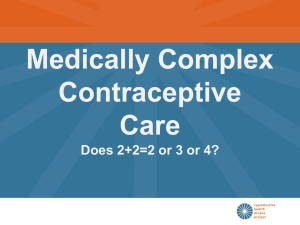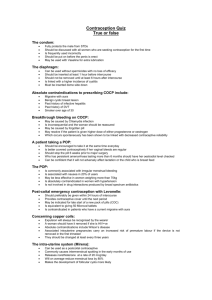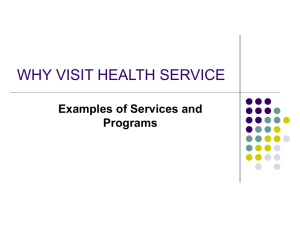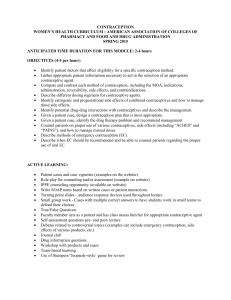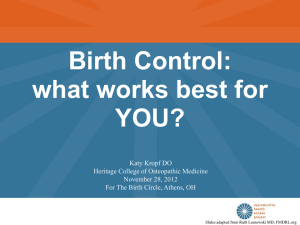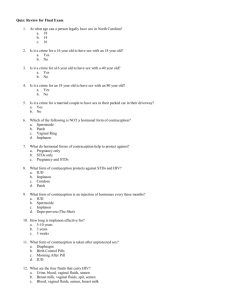Evidence_Based_Contraception_
advertisement
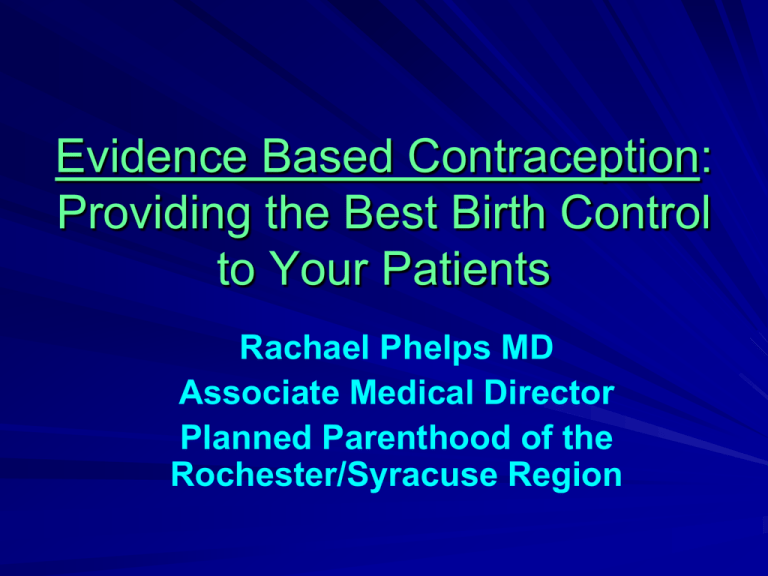
Evidence Based Contraception: Providing the Best Birth Control to Your Patients Rachael Phelps MD Associate Medical Director Planned Parenthood of the Rochester/Syracuse Region Unintended Pregnancy in the U.S. 6.3 million pregnancies Intended 51% Unintended 22% Birth 49% 20% Abortion 7% Miscarriage Finer LB, Henshaw SK. Perspect Sex Reprod Health. 2006. Current Contraceptive Options Most effective Very effective Moderately effective Effective Prevents pregnancy >99% of the time Prevents pregnancy ~91-99% of the time Prevents pregnancy ~81-90% of the time Prevents pregnancy up to 80% of the time Sterilization IUD/IUS Implants Pills Patch Ring Injectables Condom Sponge Diaphragm Withdrawl Fertility awareness Cervical cap Spermicide Factors Affecting Contraceptive Use Do any of my friends use it? Do I want to prevent pregnancy? Will I be able to afford it? Will it hurt me? How will it help me? What have I heard about it? Will my parents or partner find out? Contraceptive Use and Effectiveness 31% (% of US women 15-44 years) Chandra A, et al. CDC 2005. 27% Most effective 24% Very effective Effective 8.70% 5.30% in g 1.30% Pa tc h/ R D IU PA M D ith dr aw l W s on do m C St er ili za tio n O CP 2.10% Satisfaction with Contraceptive Methods % Satisfied 87 86 80 79 75 60 4.6 4.5 4.1 MOST SATISFIED 4.1 52 3.9 3.6 3.8 LEAST SATISFIED Revisiting Your Regular Women’s Health Care Visit. 2004. Current Contraceptive Options Extremely Effective Very Effective Moderately Effective Effective Extremely Effective Male Sterilization No-scalpel vasectomy (NSV) is the standard of care A small (few mms) opening is made in the skin of the scrotal sac to deliver vas deferens Ligate/cauterize No scalpel or sutures required Extremely Effective Female Sterilization: Nonsurgical Tubal Occlusion Brand name: Essure® Brand name: Adiana ® Micro-inserts placed into proximal fallopian tubes No reported pregnancies to date Low-level radiofrequency delivered to fallopian tubes Micro-inserts placed in fallopian tubes 98% effective in preventing pregnancy based on 3 years of clinical data Pollack AE. Contraceptive Technology. 2007. Ogburn T. Obstet Gynecol Clin North Am. 2007. et al. Characteristics of Intrauterine Contraception Highest patient satisfaction among methods Rapid return of fertility Safe Long-term protection Highly effective Belhadj H, et al. Contraception. 1986.; Skjeldestad F, et al. Advances in Contraception. 1988.; Arumugam K, et al. Med Sci Res. 1991.; Tadesse E. Easr Afr Med J. 1996. Extremely Effective Levonorgestrel IUD (MIRENA) • 20 mcg levonorgestrel/day • 5 years use • Amenorrhea in ~20% of users by 1 year • Primary mechanism is fertilization inhibition • Cervical mucus thickening • Sperm Inhibition (function/motility) Mirena Prescribing Information. 2000.: Trussel J. Contraceptive Technology. 2007; Hidalgo M. Contraception. 2002. Extremely Effective Copper-T IUD: PARAGARD • Copper ions • Approved for 10 years’ use • Can be used as emergency contraceptive • Primary mechanism is prevention of fertilization • Reduce motility and viability of sperm Thonneau, PF. Am J Obstet Gynecol. 2008.: Forrtney JA. J Reprod Med. 1999.: Trussel J. Contraceptive Technology. 2007. Dispelling Common Myths About IUDs In fact, IUDs: Can be used by nulliparous women Can be used by women who have had an ectopic pregnancy Can be used by women with multiple partners Can be used by women with h/o STI/PID Can be used by teens Do not need to be removed for PID treatment MacIsaac L. Obstet Gynecol Clin N Am. 2007; Toma A. J Pediatr Adolesc Gynecol. 2006. Safety: IUDs Do Not Cause PID PID incidence for IUD users is similar to that of the general population Risk is increased only during the first month after insertion Preexisting STI at time of insertion, not the IUD itself, increases risk Rule Out GC/CZ Prior to Insertion Svensson L, et al. JAMA. 1984; Sivin I, et al. Contraception. 1991; Farley T, et al. Lancet. 1992. Safety: IUD Does Not Cause Infertility 2000 women case-control IUD users not more likely to have infertility than gravid controls (OR=0.9) Women with Cz antibodies more likely to be infertile (OR=2.4) IUD is not related to infertility Chlamydia is related to infertility Similar results in multiple studies Hubacher D, et al. NEJM. 2001. Rapid Return to Fertility Pregnancies (%) 100 80 IUC 60 OC Diaphragm 40 Other methods 20 0 0 12 18 24 30 36 Months After Discontinuation Based on data from Vessey MP, et al. Br Med J. 1983. 42 Screening: Appropriate Candidates for Intrauterine Contraception Copper T IUD (Paragard) LNG IUD (Mirena) • Want regular periods • Want no hormones • No h/o dysmenorrhea • No h/o menorrhagia OK w/irregular bleeding OK w/amenorrhea H/O dysmenorrhea H/O menorrhagia Extremely Effective Implant: IMPLANON Contains etonogestrel Effective for 3 years Mechanism: Inhibits ovulation Side effects: amenorrhea or irregular bleeding Implanon insert: Diaz S., Contraception, 2002: Trussel J, Contraceptive Technology, 2007 Croxatto HB, Contraception, 1998; Diaz S, Contraception, 2002; Funk S, Contraception, 2005. Implanon Prescribing Information. et al. IMPLANON™ Applicator IMPLANON™ Insertion IMPLANON™ [package insert]. Roseland, NJ: Organon USA Inc; 2006. What is the timing of insertion??? That pregnancy can be excluded Alvarez PJ. Ginecol Obstet Mex. 1994. O’Hanley K, et al. Contraception. 1992. How can you exclude pregnancy? Negative pregnancy test + No unprotected sex for 2 weeks Current Contraceptive Options Extremely Effective Very Effective Moderately Effective Effective Very Effective Combined Oral Contraceptives Contain estrogen & progestin Most newer formulations contain 20 – 35 mcg of ethinyl estradiol 1 of 8 available progestins Trussel J. Contraceptive Technology. 2007:Rosenberg MJ. Reprod Med. 1995: Potter L. Fam Plann Perspect. 1996; Mosher WD. AdvanceData. 2004. Hardman JG. McGraw-Hill. 1996.: Goldzieher JW. Fertil Steril. 1971.: Moghissi KS. Fertil Steril. 1971. Estrogen-Related Side Effects Estrogen dose 20-35 mcg Breast tenderness Nausea Vomiting Headaches Elevated blood pressure (rare) Progestin-Related Side Effects Most Androgenic: levonorgestrel, norgestrel Androgenic: norethindrone, ethynodiol diacetate Least Androgenic: desogestrel, norgestimate Spirinolactone like: drosperinone Bloating Anxiety/Irritability/Depression Menstrual irregularities Libido 30 Very Effective Transdermal Patch: Ortho Evra Beige-colored patch changed once per week 3 weeks on/1 week off 9 days of medication in each patch Abrams LS. Fertil Steril. 2002: Ortho Evra Prescribing Information. Archer DF, et al. Fertil Steril. 2002.; Zacur HA, et al. Fertil Steril. 2002.; Zieman M, et al. Fertil Steril. 2002.; Archer DF, et al. Contraception. 2004.; Audet MC, et al. JAMA. 2001. Counseling Issues and Facilitating Use Application Reapplication •Place on clean, dry skin on arm, torso, buttocks, or stomach, NOT the breast •Must stick directly to skin •No patch during the 4th week Apply a new patch after day 7 even if still bleeding Missed or Late Patch Use back-up method when: •On for >9 days •Off for >7 days •Falls off >24 hrs Very Effective Vaginal Ring: Nuva Ring Flexible, unfitted ring placed in vagina In 3 weeks/out 1 week 4 weeks of medication in ring Continuous use: change first of each month NuvaRing Prescribing Information. Organon. 2001: Timmer CJ. Clin Pharmacokinet. 2000. Herndon EJ. Am Fam Physician. 2004: Dieben TO. Obstet Gynecol. 2002: Linn ES. Int J Fertil. 2003. et al. Counseling Issues and Facilitating Use Placement Reinsertion Pinch ring and place into vagina. There is no wrong way to place. If its uncomfortable, place deeper. Insert ring for 3 weeks, then remove for 1 week. After 7 ring free days, place a new ring even if still on menses. Missed or Late Ring Use back-up when: In for > 5 weeks Out for > 7 days Falls out > 3 hrs Extended Hormonal Contraception Delays or eliminates menstruation Menstrual and nonmenstrual benefits Extended methods: • Continuous use of COCs, transdermal patch & vaginal ring • Seasonale®, Seasonique ® & Lybrel ® dedicated extended OC regimen Anderson FD. Contraception. 2003. Kaunitz AM. Contraception. 2000. ARHP. 2003. NuvaRing Product Information. 2001. Stewart FH. Obstet Gynecol. 2005. Kwiecien M. Contraception. 2003. Sulak PJ. Am J Obstet Gynecol 2002. Very Effective Injectable: DMPA • Depot Medroxyprogesterone Acetate (Depo-Provera ) • IM or SQ injection every 3 months (13 weeks) Trussel J. Contraceptive Technology. 2007. Cromer BA. Am J Obstet Gynecol. 2005. Trussel J. Contraception. 2004.; Westhoff C. Contraception. 2003. et al. Very Effective Progestin-Only Oral Contraceptives Called the “mini-pill” Two formulations: norethindrone & norgestrel No placebo week Timing crucial Apgar BS. AFP. 2000; WHO MEC. 2004. Contraception Report. 1999. Apgar BS. AFP. 2000. et al. Current Contraceptive Options Extremely Effective Very Effective Moderately Effective Effective Moderately Effective Withdrawal Effectiveness is similar to male condom 96% 98% Withdrawal Male condom 82% Perfect Use 83% Typical Use Jones RK. Contraception. 2009. Emergency Contraception (EC): Dispelling Myths: The morning after pill is not the abortion pill EC does not cause an abortion EC does not harm an existing pregnancy EC does not affect future fertility EC does prevent unwanted pregnancy and abortion EC Methods Brand: Plan B® One-Step (one pill) Generic: Next Choice (two pills) • behind counter > 17 year • prescription <17 years Ella Ulipristal Acetate- FDA approved High doses of OCs Copper-T IUD Emergency Contraception Most effective the sooner it is taken Taking 2 generic pills at once increases compliance without more side effects Can be taken up to 5 days after unprotected intercourse Advance provision increases use and effectiveness Piaggio G. Lancet. 1999. Task Force on Postovulatory Methods. Lancet. 1998. Grimes DA. Ann Intern Med. 2002. Croxatto HB. Contraception 2001. Raine T. Obstet Gynecol. 2000. Gold MA. J Pediatr Adolesc Gynecol. 2004. Grimes DA. Ann Intern Med. 2002. Initiation of Hormonal Contraceptives Pregnancy test Pelvic exam Pap smear STI screening Leeman L. Obstet Gynecol Clin N Am. 2007 Quick Start Method: New Approach Improving Contraceptive Initiation Start method (OCP, Ring, Patch, DMPA) today (if pregnancy test is negative) If unprotected IC in past 5 days: Start method today Also offer EC If unprotected IC in past 2 weeks: Start method today RTC for pregnancy test in 3 weeks Back-up for 7 days When is she protected from pregnancy? Immediately: Copper-T IUD After 7 Days: LNG IUS Implant Pills Patch Ring Injectable Weighing the Risks & Benefits Burkman R. Am J Obstet Gynecol. 2004. Risk Perception “When providers and/or patients hold misperceptions about the risks associated with contraception, women’s choices may be unnecessarily limited.” Combined Hormonal Contraception Has Many Health Benefits Menstrual-related health benefits: Decreased dysmenorrhea Decreased menstrual blood loss and anemia May reduce menstrual-related PMS symptoms Decreased risk of: Ectopic pregnancies Endometrial and ovarian cancer risk Benign breast conditions PID Decreases Effectiveness of OCP, Patch, Ring, POP, : Carbamazepine (Tegretol, Equetro, Carbetrol) Oxcarbazepine (Trileptal) Phenobarbital Phenytoin (Dilantin) Primidone (Mysoline) Topiramate if >200 mg/day (Topamax) Modofinil (Provigil) Lamictal (not a problem for POP) Combined Hormonal Contraception Has Few Contraindications (all related to estrogen) Clotting disorders History of DVT or PE Migraine with aura or focal neurological deficit Uncontrolled HTN Smoker over age 35 SLE w/ + antiphospholipid antibody Resource: CDC U.S. Medical Eligibility Criteria Incidence of VTE per 100,000 woman-years Comparative Risks of VTE 60 40 20 0 Pregnancy High-dose Low-dose (50) OC (20-35) OC Shulman LP. J Reprod Med. 2003. Chang J. In: Surveillance Summaries. 2003. General Population Fatal Cardiovascular Events (MI,VTE,Stroke) per 100,000 35.9 AGE: 40-44 35-39 30-34 15 13.1 3.7 2.3 1.5 Non-smoker Non-user 6.3 3.4 2.1 Non-smoker OC-user 6.6 3.6 5.9 Smoker Nonuser Smoker OCuser Farley TMM, Collins J, Schlesselman JJ. Contraception. 1998 Cardiovascular Adverse Events in Context Incidence is low in reproductive-age women, with or without OC use Mortality associated with combined OC use is low among women aged less than 35 years, even if they smoke. Among healthy women over 35 years, the additional mortality associated with oral contraceptive use is 1.4 per 100 000 users per year Smoking has greater effect on cardiovascular event incidence and mortality than OC use at all ages Farley TMM, Collins J, Schlesselman JJ. Contraception. 1998. A Final Thought “…Two times a very rare event is still a very rare event.” David Grimes, MD 2006 DMPA and Bone Loss Women lose 1-3% of BMD/year of use In 2004: FDA added a black box warning to address DMPA and BMD Loss appears to be transient. 2005 study: Recovery complete in 12 months following discontinuation Duration of use does not impact recovery Scholes D, et al. Arch Pediatr Adolesc Med 2005;159:139–144 Berenson AB, et al. Am J Obstet Gynecol 2001;98:576-82 57 DMPA and Weight Gain 18% of adolescents report discontinuing for this reason 2 retrospective analyses : DMPA associated with an increase of 9 lbs. Only randomized trial: DMPA had no effect on weight over a 3 month period Polaneczky M, et al. J Adolesc Health 1998;23:81-88 Bahamondes L, et al. Contraception 2001;64:223-225 Mangan SA, et al. J Pediatr Adolesc Gynecol 2002;15:79-82 CDC U.S. Medical eligibility criteria (USMEC) www.managingcontraception.com Provider Resources Resources: www.prch.org - Physicians for Reproductive Choice and Health www.aap.org - The American Academy of Pediatrics www.acog.org - The American College of Obstetricians and Gynecologists www.adolescenthealth.org - The Society for Adolescent Medicine http://www.aclu.org/reproductiverights/ - The Reproductive Freedom Project of the American Civil Liberties Union www.advocatesforyouth.org – Advocates for Youth www.guttmacher.org – Guttmacher Institute www.cahl.org/ - Center for Adolescent Health and the Law www.gynob.emory.edu - The Jane Fonda Center of Emory University www.siecus.org - The Sexuality Information and Education Council of the United States www.arhp.org - The Association of Reproductive Health Professionals Provider Resources: Contraception PRCH’s Emergency Contraception: A Practitioner’s Guide ARHP Reproductive Health Model Curriculum For emergency contraception, women can call 1-888NOT-2-LATE. Managing Contraception: http://www.managingcontraception.com Back Up Your Birth Control: Building Emergency Contraception Awareness Among Adolescents, A Tool Kit, Academy for Educational Development, http://www.aed.org/Publications/upload/ECtoolkit3283.pd f Web Resources for Patients www.arhp.org www.plannedparenthood.org www.familydoctor.org www.ashastd.org www.reproductiveaccess.org (section for consumers/patients) www.reproline.jhu.edu Fertility Postpartum Not Breastfeeding Most nonlactating women resume menses within 4 to 6 weeks, but are anovulatory Average, first ovulation occurs 45 days postpartum Duration of postpartum infertility is variable and unpredictable! Breastfeeding Ovulation can occur even though menstruation has not started. Probability that ovulation will proceed the first menses increases over time: 33% to 45% during first 3 months pp 64% to 71% during months 4 through 12 87% to 100% after 12 months Postpartum BC methods: Not Breastfeeding Immediate post delivery: DMPA Progesterone Only Pills Implanon IUD (Paragard only) 3 weeks postpartum Combined OCP Patch Vaginal Ring 4 weeks postpartum IUD (Paragard or Mirena) Postpartum BC methods: Breastfeeding Immediate post delivery: Progesterone Only Pills Implanon DMPA (or wait 4-6 weeks) IUD (Paragard) After breastfeeding established or baby’s diet supplemented (6 wks-6 months) Combined OCP Patch Vaginal Ring 4 weeks postpartum IUD (Paragard or Mirena) Breastfeeding- USMEC CHC: PILLS/RING/PATCH <6wk - 4 6wk-6months - 3 >6 months - 4 Progestin-ONLY: POP/DMPA/IMPLANT <6wk - 3 6wk-6months - 1 >6 months - 1 IUD <4wks - Paragard - 1/ Mirena - 3 >4wks - 1 for both

